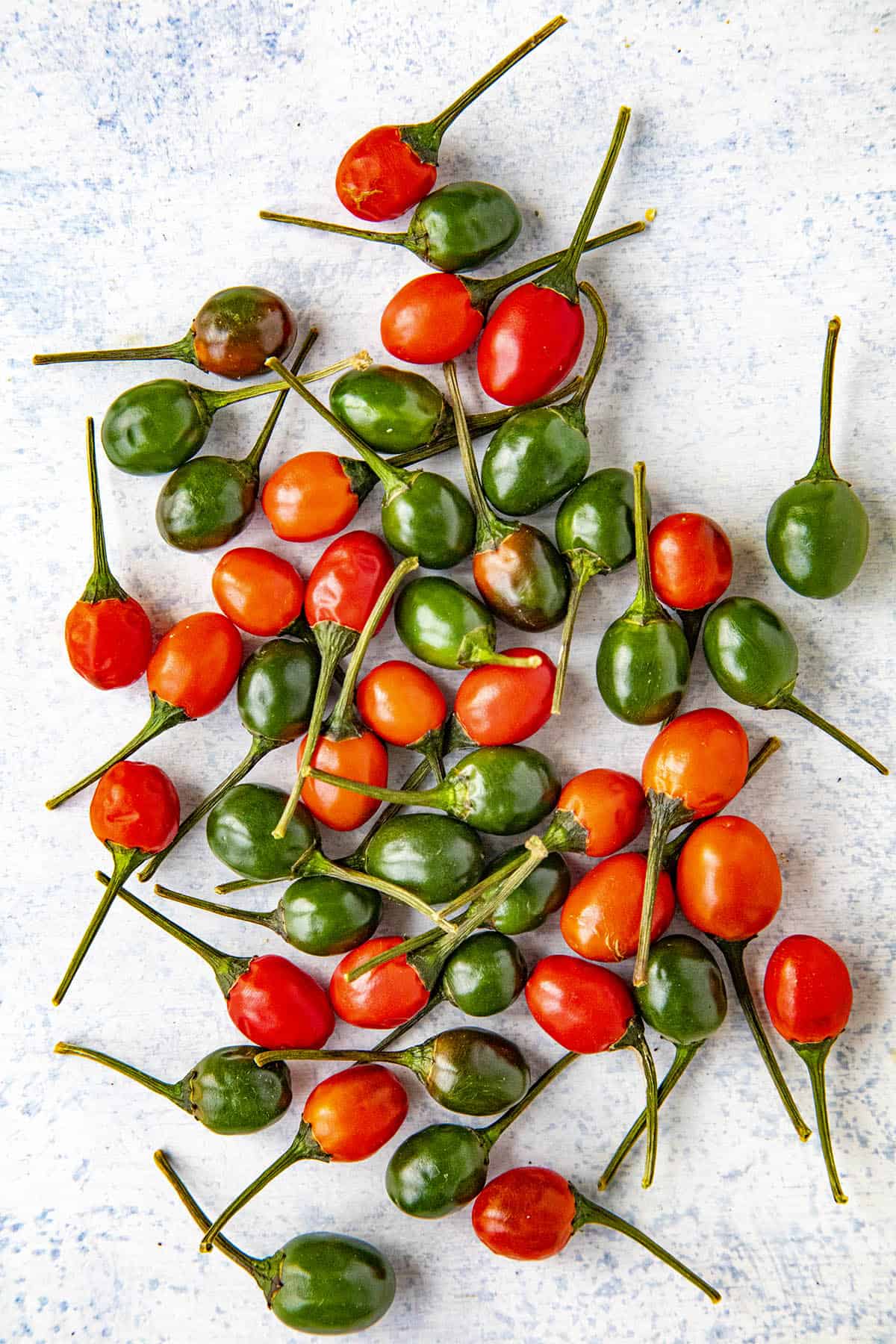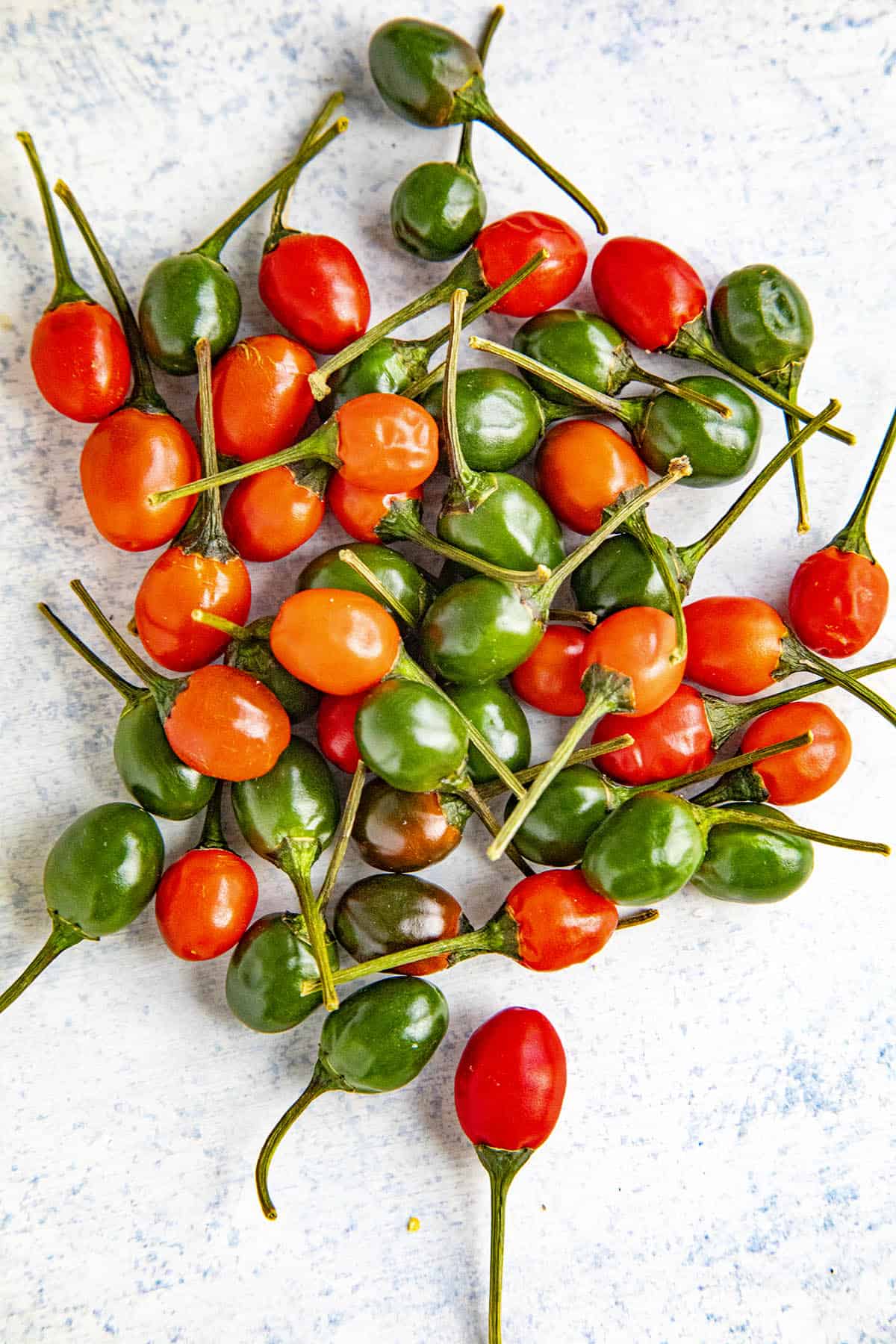The bird's eye pepper is a small round pepper originating in Thailand and surrounding countries, though they are now popular all around the world.

SCOVILLE HEAT UNITS: 50,000-100,000 SHU
The tiny Bird’s Eye Chili originated in Cambodia, Vietnam, Thailand, The Philippines, and surrounding countries, but they can now be found all over the world. They are presumably called Bird’s Eye Chili because of their small round shape and because they have been spread by birds, which are not affected by the heat of the peppers.
The Chiltepin pepper in North America is also known by the same name, and for the same reasons, but it is a different pepper altogether.
The Bird’s Eye are generally red at maturity, but may also be yellow, purple or black. They are very popular in cuisine from the areas mentioned above, and with heat almost similar to a habanero, they add quite a punch to many types of dishes, including pastas, soups, sauces, dips, and more.
Historically the hot pepper has been used as a natural remedy for arthritis, rheumatism, flatulence and toothache, and they may be used as an insect repellent when mixed with water.

How Hot is a Bird's Eye Chili?
Bird's eye chilis range from 50,000 to 100,000 Scoville Heat Units on the Scoville Scale. Compare this to a typical jalapeno pepper, which averages 5,000 SHU, and the bird's eye pepper is anywhere from 10 to 20 times hotter. That's quite a lot of heat!
Cooking with Bird's Eye Peppers
Bird's eye peppers are used extensively in Thai cuisine as well as the cuisines of many countries around Thailand. They truly pack a punch and have an excellent flavor. I've grown these pods in my garden a few times now and the plants are always productive. Because of the amount of peppers, their good level of heat, and their vibrant color, these peppers are ideal for making hot sauces, chili pastes, salsas, or for dehydrating and grinding into chili flakes or chili powders. They're also good for stir fries or adding to salads and soups.
See also these Types of Thai Chili Peppers
Got any questions? Feel free to contact me any time. Happy to help! -- Mike Hultquist
About Mike
Mike is the author of "The Spicy Food Lovers' Cookbook" and "The Spicy Dehydrator Cookbook". He is a chili pepper enthusiast who has run Chili Pepper Madness for many years.



Lester Scafidi says
Where can I find Bird's Eye peppers that you picture. When I do a search, I find peppers that are not at all like those you describe.
Mike Hultquist says
Lester, there are different types. You can order some lightly pickled ones in jars online or at Asian markets. Fresh ones are harder to get. You might check the Facebook groups online, or check the Resources page on my site.
Inez Cochran says
How can I order the seeds of the Birds Eye peppers. II want to make some peppers amuse with them like my Father Used to make years ago. I would like to order the peppers themself or some of the seeds
Mike Hultquist says
Inez, I have some Seed and Chili Plant resources listed here: https://www.chilipeppermadness.com/resources/. Good luck!
G Suckling says
Why is it that we have a verity of chillies depending on who is telling the storey that are referred to as birds eye chillies.
Fifty five years ago when I was introduced to chillies the birds eye chillie was a small rather hot chillie, similar shape to the Thai chillie but a third the size with a black dot on each side of the fruit at the stork end, hence the name. I was wondering why the change?
Mike Hultquist says
History is interesting!
Edwina says
I'm really confused right now and I'm hoping you can help. You say the Bird's Eye Peper originate in "Cambodia, Vietnam, Thailand, The Philippines, and surrounding countries" but I've read about the same pepper on other sites and they say it originated in the wild of Africa. Am I reading about two totally different peppers by the same name maybe?? I'd love to know since my son and I are currently trying our hand at raising peppers. First, we started picking up super hot peppers since my son likes hot foods, then I pointed out it might be fun raising peppers from all over the world. We want to try to make sure we don't give misinformation about any of the peppers we raise...
Mike Hultquist says
Edwina, there is also an African Bird's Eye pepper, which you can read about here: https://www.chilipeppermadness.com/chili-pepper-types/hot-chili-pepper-types/african-bird-s-eye-african-devil/
M says
Thank you Edwina! I saw the picture for the one from Africa and then realized that the Birds Eye pepper I knew did not look like those! Thought I was crazy!
Paula Schechter says
I was gifted a baggie of the Birds Eye peppers from my friend’s garden. I would like to make a jelly with them. I am aiming for mild heat. How many should I grind up and cook in the hot jelly liquid (I plan to make twelve, 8 ounce jars) ?
If I add 2 or 3 whole peppers after pouring into the jar will it appreciably effect the heat level? I want to add the whole peppers for aesthetic reasons.
Final question, do you have any suggestion for what would pair as a nice 2nd flavor to the jelly? Tequila? An herb?
Many thanks!
Mike Hultquist says
Paula, I have a number of jellies/jams recipes that you can refer to here: https://www.chilipeppermadness.com/chili-pepper-recipes/jellies/. You'll find ideas for amounts and other flavor additions, like fruit. Bird's eyes are pretty hot, so a little goes a long way.
EDIT/NOTE: Paula, I received your other messages regarding this, and sorry that my answer was not sufficient. I can't really tell you exactly how many bird's eye peppers to use. I directed you to view other recipes for amounts, but as mentioned, heat levels can vary. I suggest you use one of my other recipes, like the jalapeno jelly recipe, for amounts. You can refer to the other recipes there for ideas on other ingredients you can add, like fruits. I can't really write a new recipe for you that uses bird's eyes. My suggestion is to use one of the other recipes and use bird's eyes in place of the other chilies. I do hope this makes more sense this time.
Doris Vincent says
I’d like to make a pumpkin soup that calls for a bird’s eye or habaero pepper. I want the flavour but we can’t take much heat. In addition to removing the seeds what can I do?
Mike Hultquist says
Hi, Doris. You CAN scoop out the innards and seeds, but if that's too hot, you can use milder peppers instead. I'm not sure what heat level you enjoy, but you might skip the habanero and use a sweet pepper. The bird's eyes are quite hot by themselves. You can even dial back on the bird's eye and use sweeter peppers, or milder jalapenos.